The Eight Extraordinary Meridians are a category of the body’s meridian pathways. They include the Du Mai (Governing Vessel), Ren Mai (Conception Vessel), Chong Mai (Penetrating Vessel), Dai Mai (Belt Vessel), Yang Wei Mai (Yang Linking Vessel), Yin Wei Mai (Yin Linking Vessel), Yin Qiao Mai (Yin Heel Vessel), and Yang Qiao Mai (Yang Heel Vessel). Unlike the twelve regular meridians, they do not directly connect to the organs and do not have a paired relationship with the exterior, hence they are referred to as “extraordinary meridians”.What are the Eight Extraordinary Meridians?
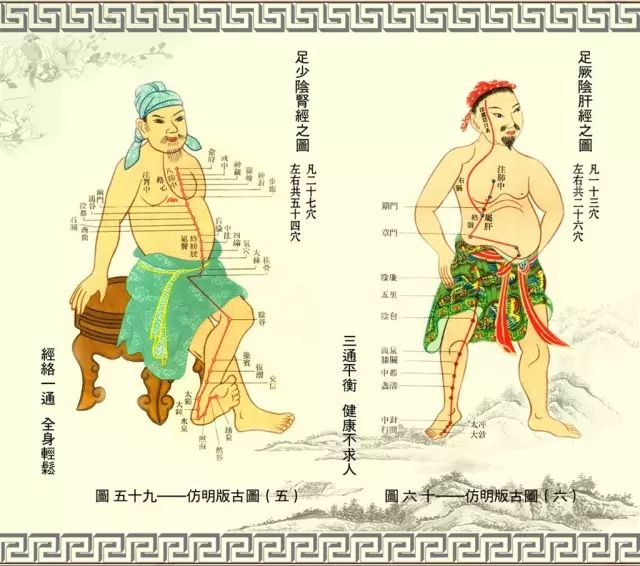
1Extraordinary Meridians
The Eight Extraordinary Meridians consist of the Ren Mai, Du Mai, Chong Mai, Dai Mai, Yin Qiao Mai, Yang Qiao Mai, Yin Wei Mai, and Yang Wei Mai. They differ from the twelve regular meridians as they do not directly connect to the organs and lack a paired relationship with the exterior, thus they are termed extraordinary meridians.
Functions:
1. To communicate the connections between the twelve meridians;
2. To regulate the accumulation and distribution of Qi and blood in the twelve meridians.
2Eight Meridians
1.Ren Mai: Runs along the midline of the abdomen, frequently intersecting with the three Yin meridians of the hands and feet as well as the Yin Wei Mai, thus governing all Yin meridians in the body, hence called the “Sea of Yin Meridians”. The Ren Mai originates from the uterus, relating to women’s pregnancy, hence the saying “Ren governs the uterus”.
2.Du Mai: Runs along the midline of the back, frequently intersecting with the three Yang meridians of the hands and feet as well as the Yang Wei Mai, thus governing all Yang meridians in the body, hence called the “Sea of Yang Meridians”. The Du Mai runs along the spine, ascends into the brain, and branches off to connect with the kidneys, closely related to the brain, spinal cord, and kidneys.
3.Chong Mai: Ascends to the head and descends to the feet, penetrating the entire body; it serves as a crucial point for Qi and blood, regulating the Qi and blood of the twelve meridians, hence called the “Sea of the Twelve Meridians” or “Blood Sea”. It is also related to women’s menstruation.
4.Dai Mai: Originates from the lateral costal region, descends obliquely to the Dai Mai point, encircling the body like a belt, restraining the meridians that run vertically.
5, 6.Yin Qiao Mai, Yang Qiao Mai: “Qiao” implies agility and quickness. They nourish the eyes, control the opening and closing of the eyelids, and facilitate lower limb movement.
7, 8.Yin Wei Mai, Yang Wei Mai: “Wei” implies connection. The function of the Yin Wei Mai is to “connect all Yin”, while the Yang Wei Mai’s function is to “connect all Yang”.
Physiological Functions of the Eight Extraordinary Meridians

1. Further strengthens the connections between the twelve meridians: for example, the Du Mai governs all Yang meridians; the Ren Mai connects all Yin meridians; the Dai Mai restrains the vertical meridians. The Yin and Yang meridians govern the left and right sides of the body; the Yin and Yang Wei meridians connect the exterior and interior of the body. Thus, the Eight Extraordinary Meridians further enhance the connections among various parts of the body.
2. Regulates the Qi and blood of the twelve meridians: when the Qi of the twelve meridians is abundant, it is stored in the Eight Extraordinary Meridians; when the Qi and blood of the twelve meridians are insufficient, the Eight Extraordinary Meridians can “overflow” to provide timely supplementation.
3. The Eight Extraordinary Meridians are closely related to the liver, kidneys, and other organs, as well as the uterus in women, the brain, and the marrow, having significant physiological and pathological connections.
Circulation and Physiological Functions of the Eight Extraordinary Meridians
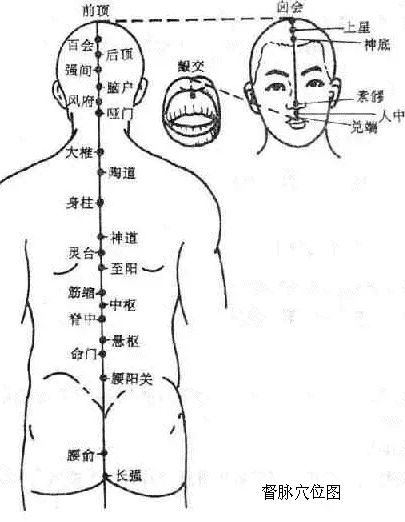
1Circulation and Physiological Functions of the Du Mai
1. Circulation Path: The Du Mai originates from the lower abdomen, exits at the perineum, travels to the tailbone at the Changqiang point, ascends along the spine, passes through the nape to the Fengfu point, enters the brain, belongs to the brain, runs along the midline of the head, ascends to the Baihui point at the top of the head, descends through the forehead to the Suliao point at the tip of the nose, passes through the philtrum, and reaches the Gingjiao point at the center of the upper gums.
2. Branches: The first branch, along with the Chong and Ren meridians, originates from the uterus, exits at the perineum, and meets the Qi of the foot Shaoyin Kidney meridian and foot Taiyang Bladder meridian at the tailbone, penetrating the spine and belonging to the kidneys. The second branch ascends directly from the lower abdomen through the navel, reaches the heart, and meets the Chong and Ren meridians at the throat, then circles around the lips to the center below the lower jaw. The third branch, originating from the inner corner of the eye along with the foot Taiyang Bladder meridian, ascends to the forehead, meets at the top of the head, connects to the brain, and then branches down the nape, along the inner scapula, beside the spine, reaching the waist, and enters the muscles on both sides of the spine, connecting with the kidneys.
3. Physiological Functions
(1) Regulates the Qi and blood of the Yang meridians, serving as the “Sea of Yang Meridians”: The Du Mai runs along the back, which is Yang, indicating that it has a commanding and supervising role over the Qi of all Yang meridians. Additionally, all six Yang meridians intersect with the Du Mai at the Dazhui point, thus it has a regulatory effect on the Yang meridians, hence the saying “governs all Yang meridians”.
(2) Reflects the functions of the brain, kidneys, and spinal cord: The Du Mai belongs to the brain and connects with the kidneys. The kidneys produce marrow, and the brain is the sea of marrow. The relationship between the Du Mai, brain, kidneys, and spinal cord is very close.
(3) Governs reproductive functions: The Du Mai connects with the kidneys, and since the kidneys govern reproduction, the Du Mai is related to reproductive functions.
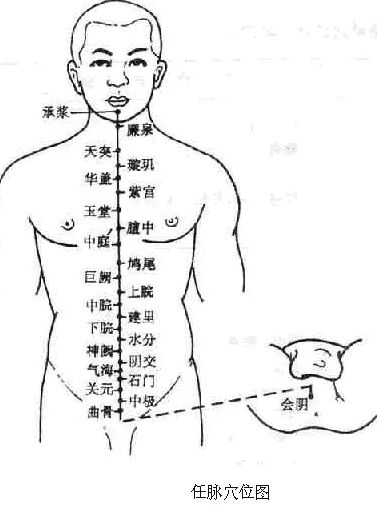
2Circulation and Physiological Functions of the Ren Mai
1. Circulation Path: The Ren Mai originates from the uterus, exits at the perineum, travels through the Yinfu, ascends along the midline of the abdomen, passes through the throat (Tiantu point), and reaches the inner lower lip, dividing left and right, encircling the lips, meeting at the Gingjiao point of the Du Mai, then passing through the sides of the nose, ascending to the lower eye socket (Chengqi point), and connecting with the foot Yangming meridian.
2. Branches: It penetrates the spine from the uterus, ascending along the back.
3. Physiological Functions
(1) Regulates the Qi and blood of the Yin meridians, serving as the “Sea of Yin Meridians”: The Ren Mai runs along the midline of the abdomen, which is Yin, indicating that it has a comprehensive and governing role over the Qi of all Yin meridians. Additionally, the three Yin meridians of the foot intersect with the Ren Mai in the lower abdomen, and the three Yin meridians of the hand connect with the Ren Mai through the three Yin meridians of the foot, thus the Ren Mai has a regulatory effect on the Qi and blood of the Yin meridians, hence the saying “governs all Yin”.
(2) Regulates menstruation and nourishes the fetus: The Ren Mai originates from the uterus, thus it has the function of regulating menstruation and promoting women’s reproductive functions, hence the saying “Ren governs the uterus”.
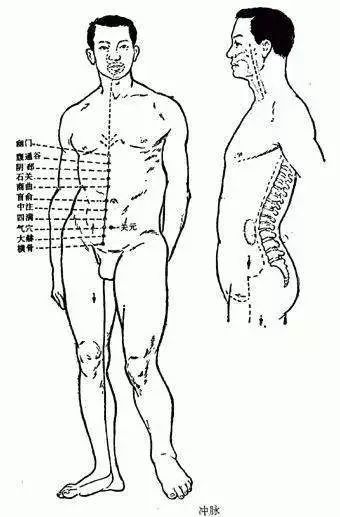
3Circulation and Physiological Functions of the Chong Mai
1. Circulation Path: It originates from the uterus, exits at the perineum, and divides into two branches. The ascending branch (the main part of the Chong Mai) runs along the anterior abdominal wall, near the navel (five fen beside the navel), ascends, parallels the foot Shaoyin meridian, spreads in the chest, then ascends through the throat, encircling the lips; the descending branch exits the perineum and descends along the inner thigh to the big toe.
2. Physiological Functions
(1) Regulates the Qi and blood of the twelve meridians: The Chong Mai ascends to the head and descends to the feet, penetrating the entire body, serving as a crucial point for the Qi and blood of the meridians. When the Qi and blood of the meridians are abundant, the Chong Mai can store and accumulate them; when they are insufficient, the Chong Mai can provide infusion and supplementation to maintain the normal physiological activities of the body’s organs and tissues. Hence it is referred to as the “Sea of the Twelve Meridians”, “Sea of the Five Zang and Six Fu”, and “Blood Sea”.
(2) Governs reproductive functions: The Chong Mai originates from the uterus, also known as the “Blood Chamber” or “Blood Sea”. It has a role in regulating menstruation. The Chong Mai is closely related to reproductive functions; for women, “when the Chong Mai is abundant, menstruation occurs regularly, hence the offspring”. Conversely, if the Chong Mai is deficient, it can lead to reproductive dysfunction.
(3) Regulates the ascending and descending of Qi: The Chong Mai, during its circulation, connects with the foot Shaoyin, belongs to the Yangming, and connects with the Jueyin and Taiyang. It has the function of regulating the ascending and descending of Qi in certain organs (mainly the liver, kidneys, and stomach).
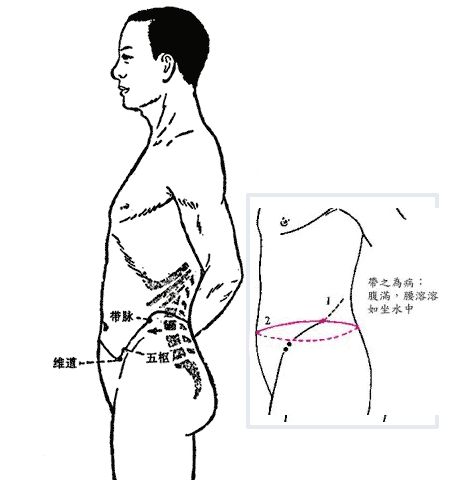
4Circulation and Physiological Functions of the Dai Mai
1. Circulation Path: The Dai Mai originates from the lateral costal region, descends obliquely, intersects with the Dai Mai point of the foot Shaoyang Gallbladder meridian, encircles the body, and then descends forward along the upper edge of the hip bone to the lower abdomen.
2. Physiological Functions: It restrains the vertical meridians and governs women’s leukorrhea.

5Circulation and Physiological Functions of the Yin Qiao Mai
1. Circulation Path: The Yin Qiao Mai originates from the inner side of the heel of the foot Shaoyin meridian at the Zhaohai point, ascends through the inner ankle, along the inner thigh to the anterior genital area, ascends along the anterior trunk to the chest, enters the Xuepen, ascends beside the Adam’s apple to the Ren Mai’s Tian Tu point, reaches the side of the nose, connects with the inner corner of the eye, and ascends along with the foot Taiyang and Yang Qiao Mai.
2. Physiological Functions: It controls the opening and closing of the eyes and the movement of muscles.

6Circulation and Physiological Functions of the Yang Qiao Mai
1. Circulation Path: The Yang Qiao Mai originates from the outer side of the heel of the foot Taiyang meridian at the Shenmai point, ascends along the outer ankle, travels up the outer edge of the lower limb to the abdomen, along the posterior outer side of the chest, through the shoulder, neck, and along the mouth to the inner corner of the eye. It connects with the foot Taiyang meridian and the Yin Qiao Mai, then ascends along the foot Taiyang meridian to meet the foot Shaoyang meridian at the Fengchi point behind the neck.
2. Physiological Functions: It controls the opening and closing of the eyes and muscle movement.
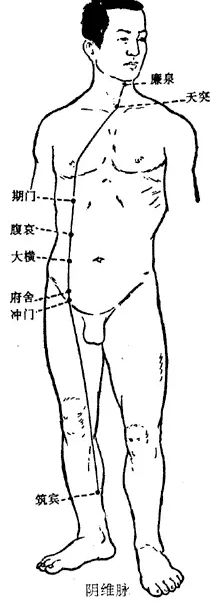
7Circulation and Physiological Functions of the Yin Wei Mai
1. Circulation Path: The Yin Wei Mai originates from the Zhubin point, five cun above the inner ankle of the foot Shaoyin meridian, ascends along the inner side of the lower limb to the abdomen, travels alongside the foot Taiyin Spleen meridian to the lateral costal region, connects with the foot Jueyin Liver meridian, then ascends to meet the Tian Tu point of the Ren Mai, and ends at the Lianquan point in the throat.
2. Physiological Functions: The “Wei” character implies connection. The Yin Wei has the function of connecting the Yin meridians.

8Circulation and Physiological Functions of the Yang Wei Mai
1. Circulation Path: The Yang Wei Mai originates from the Jinmen point of the foot Taiyang meridian, passes over the outer ankle, ascends along the outer edge of the lower limb, travels through the posterior outer side of the trunk, from the back of the shoulder, through the neck, and forward to the forehead, distributing to the side of the head and the back of the neck, connecting with the Du Mai.
2. Physiological Functions: It connects the Yang meridians.
The Eight Extraordinary Meridians are the Great Medicine of the Human Body, Capable of Treating a Wide Range of Illnesses!
The Eight Extraordinary Meridians consist of the Du Mai, Ren Mai, Chong Mai, Dai Mai, Yin Wei Mai, Yang Wei Mai, Yin Qiao Mai, and Yang Qiao Mai.
They differ from the twelve regular meridians as they do not directly connect to the organs and lack a paired relationship with the exterior, hence they are referred to as “extraordinary meridians”. The Eight Extraordinary Meridians are our lifelines; as long as you massage the major points on these meridians daily, allowing the points to open the meridians, you will feel as if a refreshing energy has entered your body.
The Eight Extraordinary Meridians consist of the Du Mai, Ren Mai, Chong Mai, Dai Mai, Yin Wei Mai, Yang Wei Mai, Yin Qiao Mai, and Yang Qiao Mai. They differ from the twelve regular meridians as they do not directly connect to the organs and lack a paired relationship with the exterior, hence they are referred to as “extraordinary meridians”.
Their functions are twofold: first, they communicate the connections between the twelve meridians, linking those that are close in location and similar in function, thus governing the Qi and blood of related meridians and coordinating Yin and Yang; second, they regulate the accumulation and distribution of Qi and blood in the twelve meridians. The Eight Extraordinary Meridians are like lakes and reservoirs, while the Qi of the twelve meridians is like the water of rivers. The Eight Meridians were mentioned in scattered records in the “Neijing”, but were concentrated and discussed in the “Nanjing”, which introduced the term Eight Extraordinary Meridians. The Ren Mai and Du Mai among the Eight Meridians are particularly significant due to their associated acupoints, thus they, along with the twelve meridians, are collectively referred to as the “Fourteen Meridians”. All fourteen meridians have specific circulation routes, symptoms, and associated acupoints.
Opening the Eight Extraordinary Meridians allows one to feel the smooth flow of Qi and blood throughout the body, resulting in abundant energy. The method of opening the Eight Extraordinary Meridians is a key aspect of traditional dual cultivation practices. It has been regarded as a closely guarded secret by masters throughout history, and is not disclosed in various alchemical texts and Daoist scriptures. Li Shizhen in his “Study of the Eight Extraordinary Meridians” stated, “All humans possess these eight meridians, which are closed to the Yin spirit; only the immortals can open them with Yang energy, thus achieving the Dao. The Eight Meridians are the roots of pre-natal energy, the ancestors of Qi.”
The eleventh generation inheritor of the Longmen school, Zhao Bicheng, first revealed this practice to the world in his book “Instructions on the Methods of Life and Death”, providing a detailed introduction to this practice. His disciple, Niu Jinbao, elaborated on the Eight Extraordinary Meridians in his book “Methods for Health and Longevity”. However, truly understanding and mastering this practice is not easy. Among the Eight Meridians, the Ren and Du meridians are the most important. They play a significant role in the entire dual cultivation process; as the ancients said: “The Ren and Du meridians are the noon and midnight of the human body, the path of the ascent and descent of Yang fire and Yin talisman, the place where Kan water and Li fire interact.”
The twelve meridians are the main body of the meridian system, characterized by their connection to the exterior and interior meridians, and their association with the corresponding organs. They include the three Yin meridians of the hands (Taiyin Lung Meridian, Jueyin Pericardium Meridian, Shaoyin Heart Meridian), the three Yang meridians of the hands (Yangming Large Intestine Meridian, Shaoyang Sanjiao Meridian, Taiyang Small Intestine Meridian), the three Yang meridians of the feet (Yangming Stomach Meridian, Shaoyang Gallbladder Meridian, Taiyang Bladder Meridian), and the three Yin meridians of the feet (Taiyin Spleen Meridian, Jueyin Liver Meridian, Shaoyin Kidney Meridian), collectively known as the “regular meridians”.
The connection patterns of the twelve meridians: Yin meridians and Yang meridians (mutually exterior and interior) intersect at the extremities of the hands and feet, Yang meridians intersect with Yang meridians (same name) in the head and face, and Yin meridians intersect with Yin meridians in the chest.
In addition to the twelve regular meridians, the human body has a more important balance system, which is the Eight Extraordinary Meridians. The Eight Extraordinary Meridians are our lifelines; as long as you massage the major points on these meridians daily, allowing the points to open the meridians, you will feel as if a refreshing energy has entered your body.
The Eight Extraordinary Meridians regulate the accumulation and distribution of Qi and blood in the twelve meridians. Among the Eight Meridians, there are eight representative acupoints: Gongsun, Neiguan, Linqi, Waiguan, Shenmai, Houxi, Lieque, and Zhaohai. The efficacy of each acupoint can be likened to a “nuclear reactor”, treating a wide range of conditions.
1. Neiguan Point, Nourishing Beauty and Heart Many women between the ages of 40 and 50 often experience symptoms such as palpitations, shortness of breath, and spontaneous sweating. Hospitals may not find any specific illness, only vaguely diagnosing it as menopausal syndrome or sub-health.
In fact, according to ancient wisdom, women at this age are generally in a stage of decline, with aging beginning from the Yangming meridian, gradually leading to a decline in the Qi and blood of the three Yang meridians. The head is the meeting point of all Yang meridians; when Qi and blood cannot reach the face, wrinkles and spots appear. A person’s beauty is closely related to Qi and blood. The heart governs the spirit, and its radiance is reflected in the face. The spirit of the heart relies on Qi and blood for nourishment; when Qi and blood are abundant, it naturally reflects on the face. Therefore, for women, nourishing beauty begins with nourishing the heart.
The Neiguan point belongs to the Pericardium Meridian, connects with the Ren Mai, and intersects with the Yin Wei, making it one of the Eight Meridians’ intersection points. The true efficacy of the Neiguan point lies in its ability to open the body’s internal mechanisms, benefiting Qi and blood, calming the spirit, and nourishing beauty. The Neiguan point is easy to locate, situated two cun above the wrist crease on the inner side of the arm. When locating the point, make a loose fist and place it palm-up; use the index, middle, and ring fingers of the other hand to align with the wrist crease, and the point where the index finger touches is the Neiguan point. This acupoint can be massaged anytime and anywhere, applying pressure until a slight soreness is felt.
2. Waiguan Point, the “Clever Ear Point” Traditional Daoist medicine believes that temporary hearing issues are manifestations of insufficient Yang energy in the body. So what role does the Waiguan point play at this moment? Massaging the Waiguan point can enrich the Yuan Yang energy of the Sanjiao, guiding the Yuan Qi to circulate throughout the body. When this point is blocked, it can cause the eardrum to become slack and unable to return to its normal state.
Clinically, the Waiguan point can also be used to treat acute lumbar sprains. A patient around 40 years old bent down to pick something up and suddenly could not move his waist; any slight movement caused unbearable pain. After treatment with acupuncture and massage, the Waiguan points were needled while the patient performed twisting movements of the waist; within ten minutes, the pain completely disappeared, and he could move normally. The Waiguan point is a Luo point of the Sanjiao Meridian, located two cun above the wrist crease on the back of the wrist, opposite the Neiguan point. It has the effects of dispelling exterior pathogens, relieving wind, and alleviating pain, proving effective not only for acute lumbar sprains but also for arthritis and cervical spondylosis.
3. Lieque Point, Special Treatment for Stiff Neck and Migraine Almost everyone has experienced a stiff neck, which can be quite painful. A stiff neck is also an early signal of cervical spine issues; those who frequently experience stiff necks should take preventive measures, as it can lead to cervical spondylosis. The Lieque point has unique effects in preventing cervical spondylosis. On the human body, the Lieque point serves as a tool for repairing head-related ailments.
The “Huangdi Neijing” records that the Lieque point primarily treats migraines, headaches, and stiff necks. The “Great Compendium of Acupuncture” includes a well-known verse stating, “Seek Lieque for ailments above the neck,” indicating that this point can be used to treat and regulate all conditions above the neck. The Lieque point is easy to locate, situated 1.5 cun above the wrist crease on the radial side. When locating the point, cross the thumbs of both hands; the depression reached by the fingertips is the Lieque point. The technique for using the Lieque point primarily involves flicking.
4. Houxi Point, Treatment for Cervical and Lumbar Disorders How to locate the Houxi point? Make a fist, and the point is located at the distal end of the transverse wrist crease behind the fifth finger joint (i.e., the end of the transverse crease when the fist is made).
If you are sitting in front of a computer, you can place the Houxi points of both hands on the edge of the table, using the wrist joints to roll back and forth easily to achieve a stimulating effect. During the rolling, a slight soreness will be felt. Spending just three to five minutes daily on this can significantly benefit the cervical and lumbar regions.
5. Zhaohai Point, Treatment for Throat Pain Massaging the Zhaohai point can yield excellent results for throat pain, as it belongs to the Yin Qiao among the Eight Extraordinary Meridians and intersects with the foot Shaoyin Kidney Meridian, making it one of the key intersection points of the Eight Meridians. It has the functions of nourishing the kidneys, clearing heat, and regulating the Sanjiao, providing both nourishment and heat-clearing effects.
Sun Simiao in his “Essential Prescriptions” referred to this point as “Liu Yin”, indicating that if this point is problematic, the body’s kidney water decreases, leading to kidney Yin deficiency and causing false heat to rise. Therefore, whenever we feel discomfort in the chest, dry throat, hoarseness, or even chronic pharyngitis, we can press this point, which not only nourishes the kidneys and clears heat but also ensures smooth functioning of the Sanjiao.
To locate the point, align the soles of both feet; there is a small depression below the inner ankle, which is where the point is located (see the above image). When massaging this point, keep your mouth closed and refrain from speaking, allowing saliva to accumulate in the mouth, which should be swallowed. Generally, after pressing for three to five minutes, one will feel saliva in the throat, and the pain will quickly alleviate. Keeping the mouth closed is to facilitate the upward movement of saliva to moisten the throat, which is what the ancients referred to as the swallowing method. Massaging the Zhaohai point stimulates the essence and Qi in the kidneys, allowing fluids to rise and moisten the throat, thus alleviating throat pain naturally.
6. Shenmai Point, the Pure Yang Medicine for Cold Bodies “Stiffness in the waist and back, leg pain” is a clear sign of the bladder meridian being affected by cold pathogens. Since the Yang Qiao connects with the bladder meridian, the Shenmai point is a significant point of the bladder meridian. Therefore, the Shenmai point is the purest Yang; using this point can dispel internal cold pathogens and allow Yang energy to reach the top of the head, balancing the body and enabling agile movement.
When combined with the Xiao Qinglong Decoction, it achieves a synergistic effect of mutual resolution of exterior and interior. It helps expel cold pathogens from the body quickly while restoring one’s Yang energy, making it an excellent point for dispelling cold and reviving Yang.
The Shenmai point is an important intersection point of the Yang Qiao and Taiyang Bladder meridian, and its location is also simple, found in the depression directly below the outer ankle bone. When the body is affected by cold pathogens, it tends to curl up and shiver, which in TCM is referred to as “contraction and retraction”. The Shenmai point has the meaning of extending the meridians, quickly mobilizing the body’s Yang energy; when Yang energy is sufficient, cold pathogens will disperse.
7. Gongsun Point, Alleviating Dysmenorrhea and Spleen-Stomach Disorders
Gongsun is the Luo point of the Spleen Meridian, belonging to the spleen, connecting with the stomach, and directly communicating with the Chong Mai located in the chest and abdomen, thus it has the function of treating various disorders of the spleen, stomach, and abdominal region.
Medicine believes that treating all gynecological diseases should start with the spleen and stomach, especially for menstrual irregularities, the stomach should be prioritized. The spleen governs blood and is responsible for transformation. If the spleen and stomach are deficient and cold, they cannot transform and transport fluids, leading to dysmenorrhea, which may also be accompanied by symptoms such as vomiting, nausea, and headaches.
Women with dysmenorrhea can benefit from massaging the Gongsun point. The Gongsun point is located on the inner edge of the foot; I generally consider the Gongsun point as a region, located behind the big toe, along a large metatarsal bone on the inner side of the foot. Pressing along this bone until a significant sensation of soreness or pain is felt indicates your own Gongsun point.
8. Linqi Point, Elevating the Body’s Shaoyang Qi
The Linqi point is one of the main points on the Gallbladder Meridian, connecting with the Dai Mai, and serves as a wonderful point for regulating two meridians. The Dai Mai encircles the body around the navel, like a jade belt, restraining the vertical meridians and enhancing the connection of Qi and blood flow between the meridians, making it a very important health meridian. When using this point, a seated position with bent legs is recommended; it is located on the outer side of the foot, between the fourth and fifth toes. The Linqi point primarily elevates the body’s Shaoyang Qi, dispersing the Qi stagnation of the liver and gallbladder. Regular pressing can yield better results than professional foot therapy.
The extraordinary meridians are in contrast to the twelve regular meridians, namely the Du Mai, Ren Mai, Chong Mai, Dai Mai, Yang Qiao Mai, Yin Qiao Mai, Yang Wei Mai, and Yin Wei Mai. The content of the Eight Extraordinary Meridians was first scattered in the “Huangdi Neijing”, compiled in the “Nanjing, Chapter 27”, which proposed the name Eight Extraordinary Meridians and detailed their distribution routes and symptoms, stating: “All these eight meridians are not bound by the meridians, hence they are called the Eight Extraordinary Meridians.” The Eight Extraordinary Meridians do not connect to the organs internally, do not have corresponding acupoints externally (except for the Ren and Du meridians), and do not have paired relationships with the exterior. They are intricately interwoven among the twelve meridians, playing a role in regulating the overflow and accumulation of Qi of the regular meridians.
For ordinary people with robust blood and Qi, the twelve regular meridians, five Zang and six Fu organs all have good vitality, and the body is in a vigorous state, but the Eight Extraordinary Meridians are less involved. According to meridian theory, generally, the internal Qi fills the twelve regular meridians, and any excess internal Qi begins to flow into the Eight Extraordinary Meridians. When practitioners activate their internal Qi, they should first work on the Du Mai (this point is often reversed by those practicing Pure Land or Esoteric methods, which can cause confusion), then connect with the Ren Mai and finally transition to the Chong Mai (the two meridians on either side of the Ren Mai). This is because at this stage, although the internal Qi may be activated, the true Qi is still insufficient, so it is advisable to focus on the important meridians.
The importance of the Du Mai lies in its ability to penetrate the brain and connect with the heart; these two areas are the focal points that practitioners must first regulate. This is because when the internal Qi enters the brain through the Yinhua point, it can develop wisdom; additionally, when the internal Qi flows through the heart, practitioners can enter a subtle state of breath, reaching the realm of those who have and have not leaked, allowing them to fill their entire body with internal Qi during seemingly imperceptible breathing.

